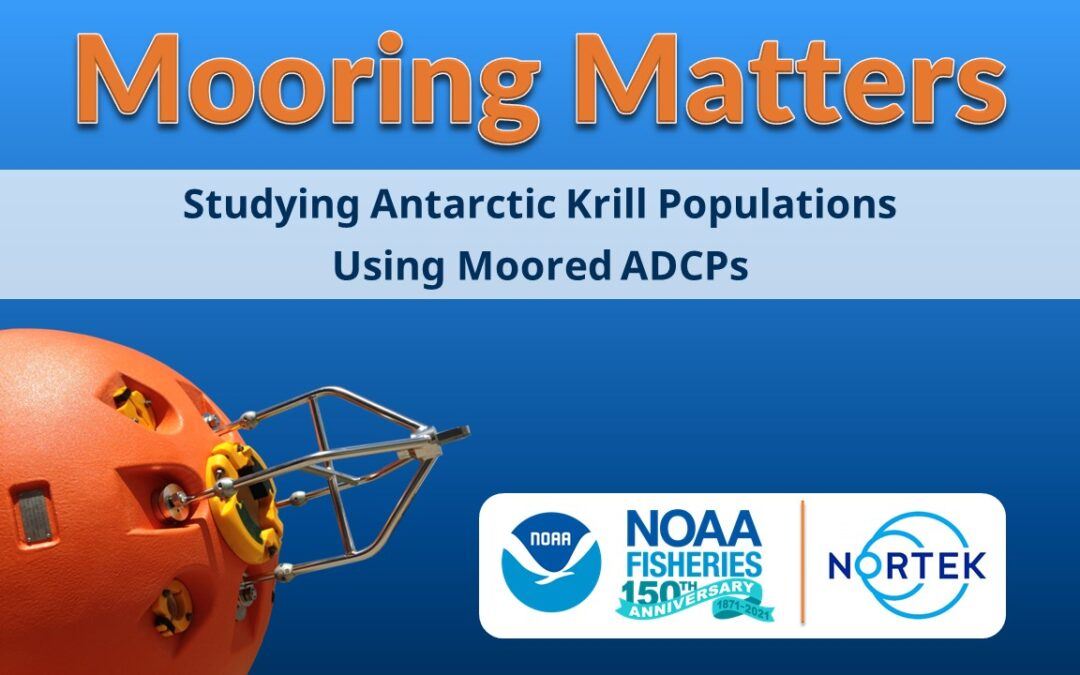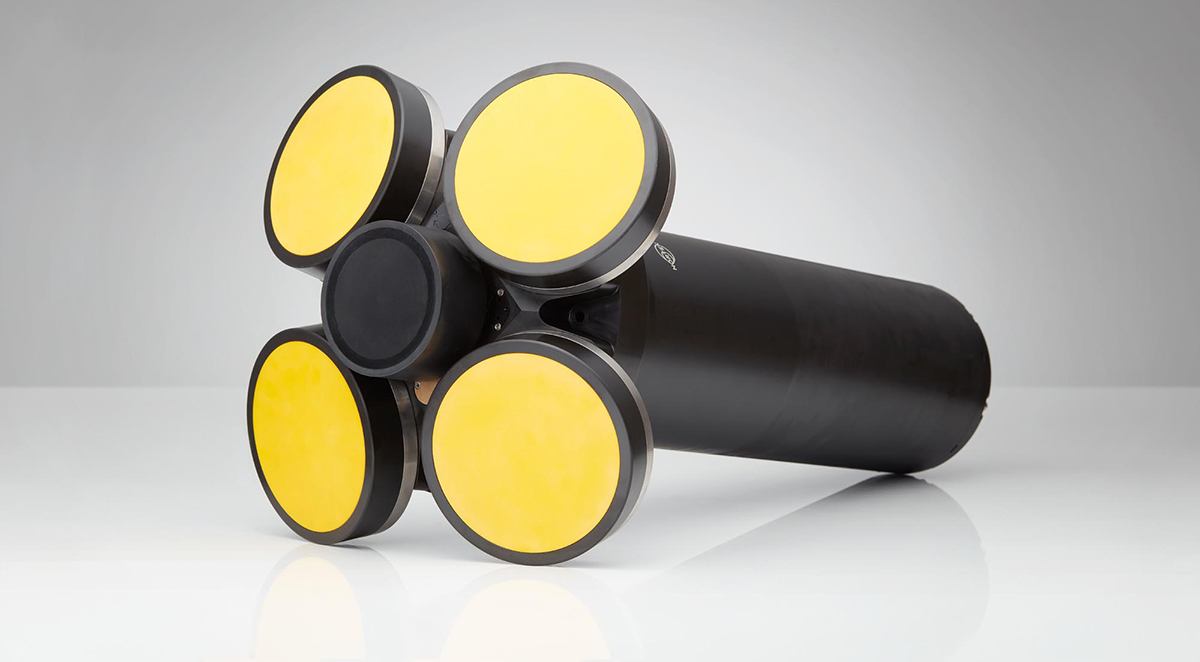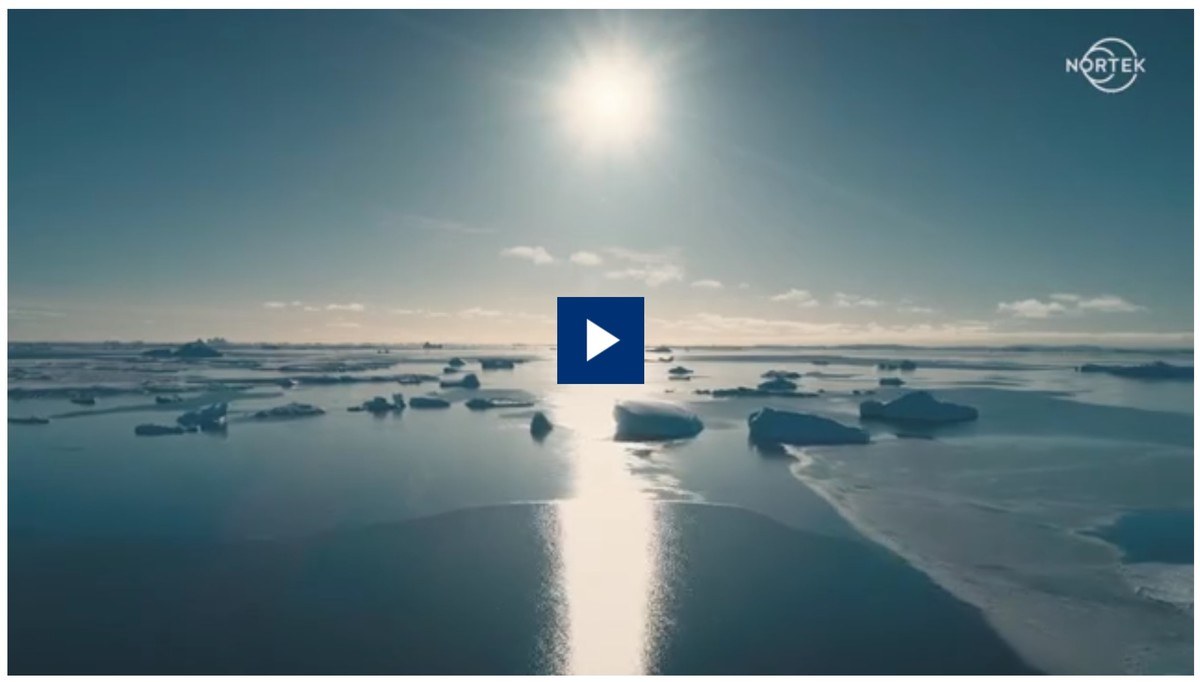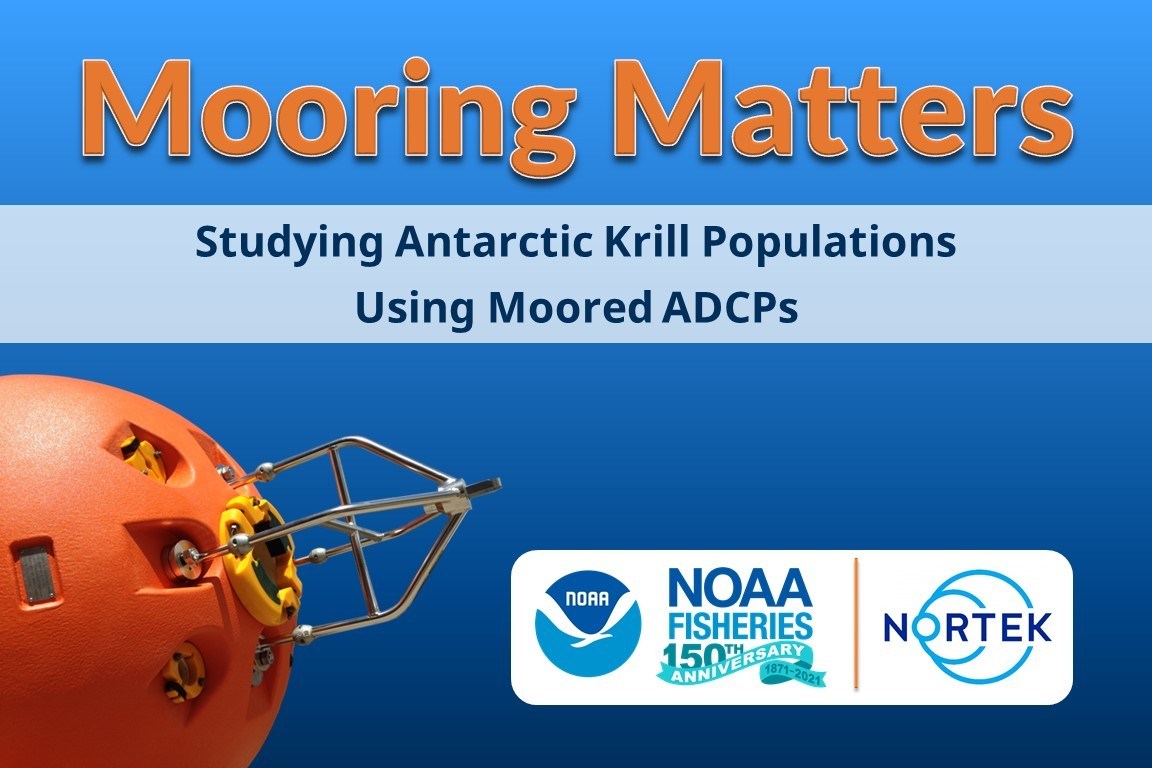
For the next installment in our series of technical articles, ADCP manufacturer Nortek and scientists at NOAA Southwest Fisheries Science Center bring us a case study on the use of moored ADCPs from Antarctica.
The study shows how changing conditions require changing technological solutions, in this case to monitor krill populations in the Southern Ocean.
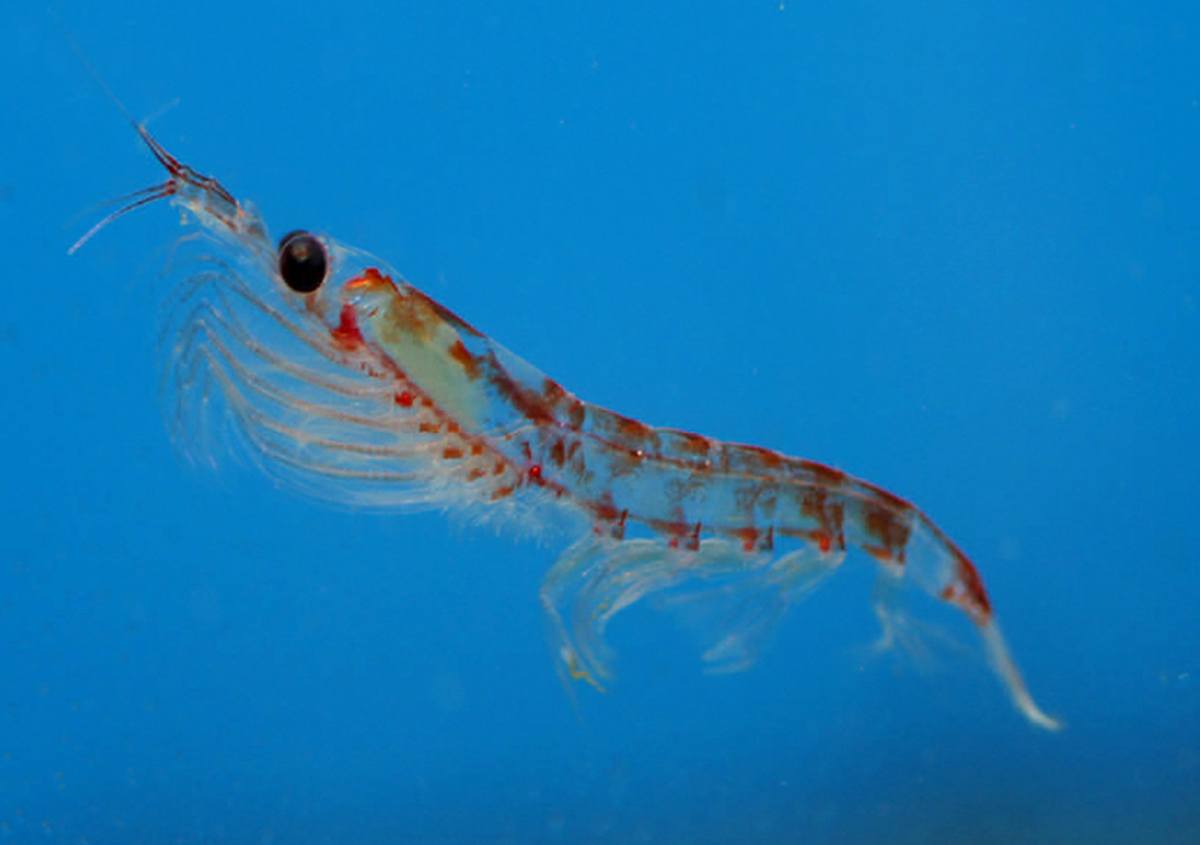
Antarctic krill are an important resource for many marine animals and are fished by humans (Photo: NOAA AERD).
Introduction
At its largest, an individual Antarctic krill measures only 6 cm in length, not much longer than a golf tee. Despite their size, these tiny creatures are of great ecological importance in the Southern Ocean. Tens of thousands of krill swim together in large swarms that can reach several kilometers in length. These aggregations of krill are an important food source to many marine animals, including whales, seals, and penguins.
Pressures on krill populations are growing as climate change and ocean acidification intensify. In addition to these changing ocean conditions, commercial fishing of krill resources is becoming more common. Responsibly managing krill populations and fisheries is crucial to conserving the Southern Ocean ecosystem.
Monitoring Krill for Ocean Conservation
Fisheries must be aware of krill abundance and distribution as to not harvest krill from an area of particular ecological importance. Scientists at NOAA’s Southwest Fisheries Science Center in the USA are working to better understand the interactions between krill, their predators, and their environment, to ensure sustainable management of krill resources.
Krill populations have been studied by NOAA’s Antarctic Marine Living Resources (AMLR) Program within the Antarctic Ecosystem Research Division (AERD) since 1986. Historically, these researchers have relied on annual ship-based research surveys to observe krill fishing areas. Data from these surveys are used to advise the Commission for the Conservation of Antarctic Marine Living Resources (CCAMLR) on fishery management strategies.
Conducting ship-based research is becoming a less viable option for krill management research, however, not only owing to its expensive and time-consuming nature, but because of shifting conditions leading to changing fishery operations. Decreasing levels of sea ice have extended the season of krill fishing into the autumn and winter, and in recent years fishing has been concentrated into smaller areas.
These changes in the timing and distribution of krill fishing created the need for a new monitoring system to observe krill populations.
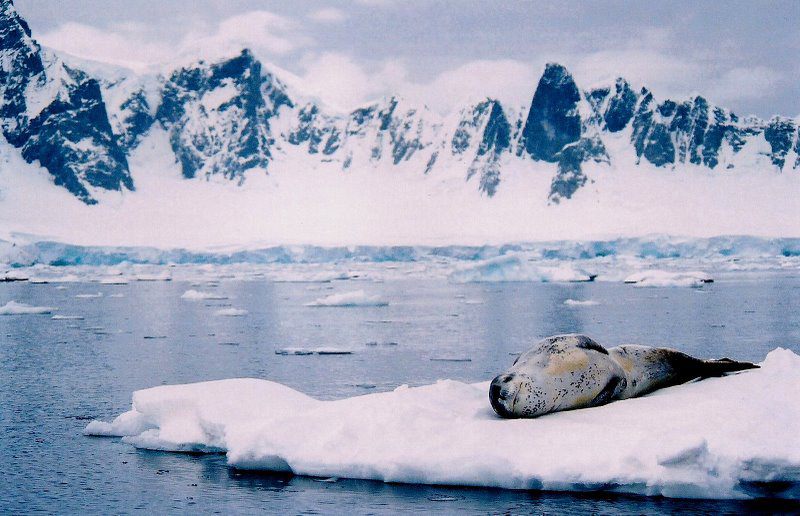
Around half of a leopard seal’s diet is made up of fish and krill, according to National Geographic. The other half? Animals like Gentoo penguins, who also rely on krill as a food source (Photo: NOAA AERD*).
A New Approach Using Moored ADCPs and Gliders
AMLR scientists developed a plan to monitor krill populations at higher spatial and temporal resolutions than before by relying on ADCP technology. The researchers settled on a two-part deployment plan: six moorings, each equipped with a Nortek Signature100 ADCP with an integrated echosounder, and two gliders, equipped with echosounders and other sensors.
The Signature 100 ADCP with integrated echosounder has an effective range of 300-400 m, allowing the researchers to observe the entire water column.
This system allows researchers to collect data on krill movement and density at appropriate temporal and spatial resolutions. The moored ADCPs provide detailed data at their respective locations, and the moving gliders collect data over a larger geographic area. Relying on this technology allows for data collection over several months, at a much lower cost than with a ship-based research program.

Deployment of the moorings in the Southern Ocean will occur year after year to monitor krill populations.
Mooring Design and Considerations
Each of the six initial moorings was outfitted with a Nortek Signature100 ADCP with an integrated echosounder, mounted upward-looking in a subsurface DeepWater Buoyancy elliptical buoy. Each mooring also had several CTDs, double releases and anchor weights.
The default depth for the top of each buoy was 350 m unless the deployment site was shallower; the shallowest site was 175 m deep with the buoy at 165 m. A low-frequency ADCP such as the Signature 100 allows for measurement of current speeds throughout the entire 350 m water column and operates at the correct frequency to identify krill. The integrated echosounder further simplifies the mooring design and deployment considerations.
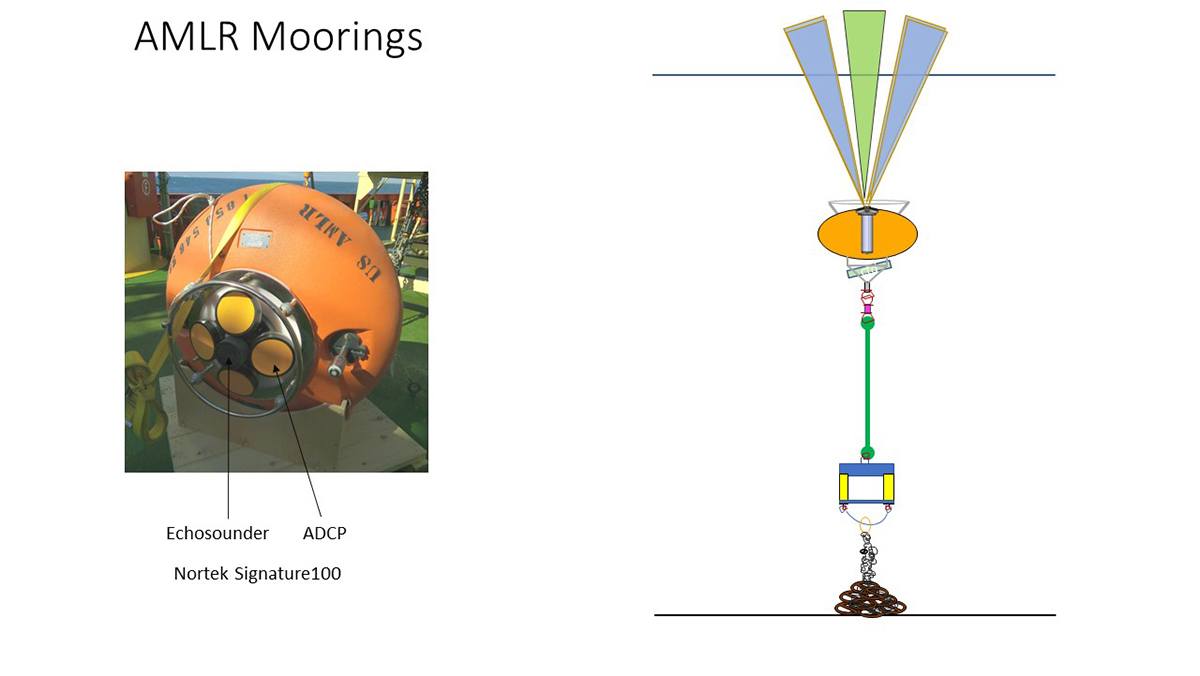
The moorings were designed to keep the ADCPs stable to gather accurate measurements (Slide: George Cutter, NOAA).
A DeepWater Buoyancy elliptical buoy was chosen to keep the ADCPs in a stable position. Keeping the ADCP upright and stable is crucial for gathering accurate ADCP and echosounder measurements. Selecting a buoy shape is a balance between size, draw down (how much the currents push the buoy), and drag. An elliptical buoy is smaller and reduces drag, but can be more easily moved by currents, as it acts as a “kite” in high velocity conditions. Knowing the current conditions in the area were generally less than 0.5 m/s, the researchers chose an elliptical buoy for the moorings.
Using the System to Gather Information about Krill
To estimate krill biomass using the ADCPs, the AMLR team used backscatter data as an index of krill biomass. The ADCPs were calibrated in a controlled tank before deployment to ensure the same amount of returned acoustic energy correlated with the same krill density for each mooring. The integrated echosounder on the Signature100 provides a “picture” of krill in the water column, further confirming these observations.

Using backscatter and echosounder data, the researchers painted a picture of krill in the Southern Ocean.
After a season of deployment, the team was able to collect data to truly “see” krill in the Southern Ocean. The ADCPs will be deployed again year after year, and the data will be used in CCAMLR to manage fishery tactics and conserve the Southern Ocean ecosystem.
*All images of marine mammals were taken in accordance with U.S. Marine Mammal Protection Act Permit #160472.
Nortek ADCP Deployment Solutions
Nortek instruments are even better with the best ADCP deployment products. DeepWater Buoyancy produces a full line of deployment products for Nortek subsea acoustic instruments.
See our solutions HERE
Learn More
Krill is an important food resource for both animals and humans, and krill harvesting must be done in a sustainable manner, based on accurate, scientific observations. Learn more about combining current and biomass measurements for unprecedented insight into ocean resources in this video.
About Nortek
Nortek designs, develops and produces scientific instruments that apply the Doppler principle to underwater acoustics in order to measure water in motion, such as currents and waves.
Learn more at nortekgroup.com
About DeepWater Buoyancy, Inc.
DeepWater Buoyancy creates subsea buoyancy products for leading companies in the oceanographic, seismic, survey, military and offshore oil & gas markets. Customers have relied on our products for over forty years, from the ocean surface to depths exceeding six thousand meters.
Learn more at DeepWaterBuoyancy.com

